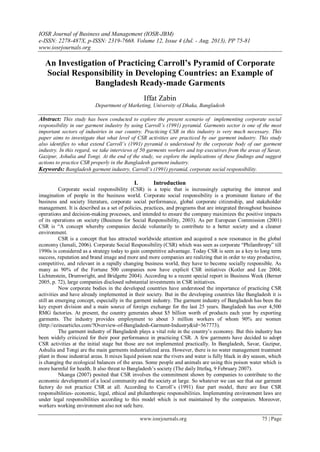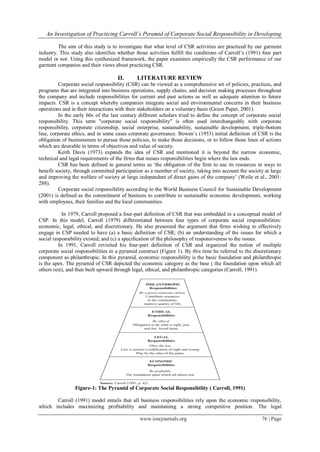This study investigates the implementation of Carroll's pyramid of corporate social responsibility (CSR) within the Bangladesh garment industry. It reveals that while CSR is increasingly recognized globally, its practice remains underdeveloped in Bangladesh, especially in the garment sector, which has faced significant criticism for poor safety and environmental standards. The research incorporates interviews from industry workers and executives to understand the extent of CSR application and suggests modifications to Carroll's model tailored for developing countries.






![An Investigation of Practicing Carroll’s Pyramid of Corporate Social Responsibility in Developing
www.iosrjournals.org 81 | Page
that can induce and enable to practice CSR in the corporate sector. The state should be strict to obey legal
obligations. Like- most of the factories do not have waste management treatment plant. But our government is
not concerned to it. If we have strong implementation of the law then our rivers would not be polluted.
Government should take appropriate measures to provide support to the companies with adequate
facilities that could enable them to protect the environment and human rights. Besides, to protect our
environment the corporate body should take the following steps-
Recycle chemical wastes and hazardous waste before disposing those.
Recycle cotton waste which generated in large volume and try to use those in other purposes.
Burn plastic and other materials before disposing those.
The corporate body of garment industry also should take necessary steps to improve the working
environment. Every factory must be included fire safety plant and factory building should be built according to
the building code of conduct. Workers job security should be increased. They should be given an appointment
letter and contract paper.
But the good thing is the situation is improving day by day. Child labor has been restricted in our
garments. Most of the garments obey the rule of paying minimum wages to the workers. They also provide
other benefits to the workers. In this case, international buyers can play a good role. They are diverting their
pressure to comply with labor rights, and improving services and workplace conditions. But their
responsibilities do not end up only with providing guidelines. They should also provide financial support to the
factories to practice CSR properly.
We hope so that this problem will be overcome with the study of CSR in our University study as well
as companies. Most of the national and multinational company‟s information disclosure process is poor.
Therefore, the regulatory body of government should be improved and powerful. Our management should be
trained well to practice better CSR, and implement it as a competitive tool in the market.
References
[1]. A join study by ILO and BILS (2007) RMG sector in Bangladesh: Status report from workers‟ perspective, CPD (2002) Corporate
responsibility practices in Bangladesh: Results from a Benchmark study, Occasional Paper Series, Paper-18, p: 12.
[2]. Bush, G. (2005) Corporate Citizenship As Part of the Business Model in J. Hancock (ed.), Investing in Corporate Social
Responsibility: A Guide to Best Practice, Business Planning and the UK‟s Leading Companies (Kogan Page, London), pp. 15–26.
[3]. Belal, A. (2001) A Study of Corporate Social Disclosures in Bangladesh, Managerial Auditing Journal 15(5), 274–289.
[4]. Bjorn Claeson. (2012) Deadly Secrets. Washington DC: International Labour Rights Forum.
[5]. Carroll, A. B. (1979) A Three-Dimensional Conceptual Model of Corporate Performance, The Academy of Management Review
4(4), 497–505.
[6]. Carroll, A. B. (1991) The Pyramid Of Corporate Social Responsibility: Toward the Moral Management of Organizational
Stakeholders, Business Horizons 34, 39–48.
[7]. Davis, K. (1973) The Case For and Against Business Assumption of Social Responsibility, Academy of Management Journal June,
312–322.
[8]. Doshi, Gaurav (2011). “Overview of Bangladesh Garment Industry” retrieved on 12 January 2007, from
http://ezinearticles.com/?Overview-of-Bangladesh-Garment-Industry&id=367773 “2013 Savar building collapse” Retrieved on 13
May 2013, from http://en.wikipedia.org/wiki/2013_Savar_building_collapse. “2012 Dhaka fire” Retrieved on 13 May 2013, from
http://en.wikipedia.org/wiki/2012_Dhaka_fire.
[9]. Drucker, P.F. (Autumn 1984) A new look at corporate social responsibility, The McKINSEY QUARTERLY, p:17-28.
[10]. Green Paper (2001), Promoting a European Framework for Corporate Social Responsibility, Directorate General for Employment
and Social Affairs, Luxemburg, European Commission.
[11]. Jim Yardley, Julfikar Ali Manik and Steven Greenhouse. (2012) Horrific Fire Revealed a Gap in Safety for Global Brands, New
York Times: Dec 6.
[12]. Malhotra, N.K. and Dash, S. (2011) “Marketing Research: An Applied Orientation”; 6th
Edition, Pearson, Delhi.
[13]. Mark, S.S and Carroll, A. B. (2003) Corporate Social Responsibility: A Three Domain Approach, Business Ethics Quarterly.
[14]. Masud, A.A, Hoque, M.A, Hossain, M.S, and Hoque, M.R. (2013) Corporate Social Responsibility Practices in Garments sector of
Bangladesh, A Study of Multinational Garments, CSR view in Dhaka EPZ, International Institute for Science, Technology and
Education.
[15]. Moinul Haque (2013) Over 700 Dead in 22 years, New Age: March 8.
[16]. Reidenbach, R.E, and Robin, D.P, (1991) A Conceptual Model of Corporate Moral Development, Journal of Business Ethics.
[17]. Strong, K.C., and G.D. Meyer. (1992) An Integrative Descriptive Model of Ethical Decision Making, Journal of Business Ethics.
[18]. Visser, Wayne (2006) Revisiting Carroll‟s CSR Pyramid, An African perspective, chapter 1 in Corporate Citizenship in Developing
Countries, Mahad Huniche, Frederiksberg: Copenhagen Business School.
[19]. Visser, Wayne, Matten, Dirken, Pohl, Manfred and Tolhurst, Nick (2007) The A to Z of corporate social responsibility, John Wiley
& Sons, Chichester.
[20]. Wood, D. (1991) Corporate Social Performance Revisited, The Academy of Management Review 16(4), 691–717.
[21]. World Business Council for Sustainable Development (2001) The Business Case for Sustainable Development: Making a
Difference Towards the Johannesburg Summit 2002 and Beyond. [Online] available: http://www.wbcsd.org.](https://image.slidesharecdn.com/m01247581-150430053051-conversion-gate01/85/An-Investigation-of-Practicing-Carroll-s-Pyramid-of-Corporate-Social-Responsibility-in-Developing-Countries-an-Example-of-Bangladesh-Ready-made-Garments-7-320.jpg)